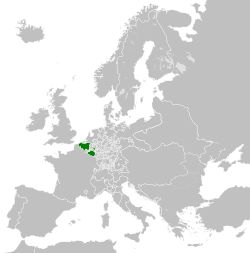United Belgian States
| United Belgian States | ||||||||||
|
Verenigde Belgische Staten États-Belgiques-Unis |
||||||||||
| Unrecognized state | ||||||||||
|
||||||||||
|
||||||||||
|
Motto In Unione Salus or Domini est Regnum "In Union Salvation" and "The kingdom is the Lord's" |
||||||||||
|
The United Belgian States' territory in 1790
|
||||||||||
| Capital | Brussels | |||||||||
| Languages | Dutch, French | |||||||||
| Religion | Roman Catholic | |||||||||
| Government | Confederal Republic | |||||||||
| President | ||||||||||
| • | 1790 | François de Nélis | ||||||||
| • | 1790 | Hendrik van Crumpipen | ||||||||
| Prime Minister | ||||||||||
| • | 1790 | Hendrik Van der Noot | ||||||||
| Legislature | Sovereign Congress | |||||||||
| Historical era | Brabant Revolution | |||||||||
| • | Manifesto of Brabant | 24 October 1789 | ||||||||
| • | Treaty of Union | 11 January 1790 | ||||||||
| • | Battle of Falmagne | 22 September 1790 | ||||||||
| • | Surrender of Brussels | 2 December 1790 | ||||||||
| Currency | See Brabant Revolution coinage | |||||||||
|
||||||||||
The United Belgian States or United Netherlandish States (Dutch: Verenigde Nederlandse Staten or Verenigde Belgische Staten, French: États-Belgiques-Unis, Latin: Foederati belgii), also known as the United States of Belgium, was a confederation in the Southern Netherlands (modern-day Belgium) which was established after the Brabant Revolution. It existed from January to December 1790 as part of the unsuccessful revolt against the Habsburg Emperor, Joseph II.
Influenced by the Enlightenment, Emperor Joseph II, who became sole ruler of the Habsburg lands after Maria Theresa's death in 1780, decreed a series of large-scale reforms in the Austrian Netherlands designed to radically modernize and centralize the political, judicial and administrative systems.
Characteristically, the well-intentioned but autocratic Emperor abruptly imposed his reforms without even a semblance of consultation with the population, which actually included an influential urban intelligentsia and other segments of the ruling classes who were highly receptive to such innovations. The Emperor's edict of tolerance of 1781 established religious freedom. Another edict in 1784 removed from the Catholic clergy responsibility for the civil registry, and civil marriage was introduced. Under the Edict on Idle Institutions (1780), contemplative religious orders, deemed useless, were dissolved and diocesan seminaries were abolished and replaced by general seminaries in Leuven and Luxembourg. Feudal and trade corporation regulations and jurisdictions were modified or abolished and, to the stupefaction of all segments of the population, the authorities abolished the ancient provinces of Flanders, Brabant, Hainaut, Namur, and Luxembourg, replacing them with 9 circles (German: Kreise), subdivided in 64 districts. Seigneurial jurisdictions and rights, including the corvée, were abolished. As in Hungary, Joseph II attempted to introduce German as the language of administration for the sake of efficiency.
...
Wikipedia



